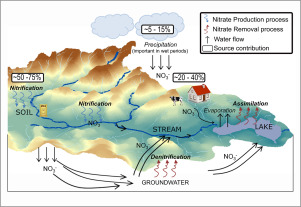当前位置:
X-MOL 学术
›
Sci. Total Environ.
›
论文详情
Our official English website, www.x-mol.net, welcomes your feedback! (Note: you will need to create a separate account there.)
A biological and nitrate isotopic assessment framework to understand eutrophication in aquatic ecosystems.
Science of the Total Environment ( IF 9.8 ) Pub Date : 2020-01-24 , DOI: 10.1016/j.scitotenv.2020.136909 Asunción Romanelli 1 , David X Soto 2 , Ioannis Matiatos 3 , Daniel E Martínez 1 , Soledad Esquius 4
Science of the Total Environment ( IF 9.8 ) Pub Date : 2020-01-24 , DOI: 10.1016/j.scitotenv.2020.136909 Asunción Romanelli 1 , David X Soto 2 , Ioannis Matiatos 3 , Daniel E Martínez 1 , Soledad Esquius 4
Affiliation

|
Eutrophication is a globally significant challenge facing aquatic ecosystems, mostly associated with human induced enrichment of these ecosystems with nitrogen and phosphorus. Given the complexity of assigning eutrophication issues to local primary N sources in field-based studies, this paper proposes a multi-stable isotope and biological framework to track nitrogen biogeochemical transformations, inputs and fate of nitrate in groundwater-dependent shallow lakes. Three representative freshwater ecosystems from the Pampa Plain (Argentina), with different land uses and topographic features were selected. Groundwater (N = 24), lake (N = 29) and stream (N = 20) samples were collected for isotope (δ15N-NO3- and δ18O-NO3-, δ18O-H2O) and hydrogeochemical (major ions and nutrients) determinations, and in the case of surface water, also for biological determinations (chlorophyll-a, fecal coliforms and nitrifying bacteria abundance). Both chemical and isotopic characteristics clearly indicated that denitrification was limited in lakes and streams, while evidence of assimilation in shallow lakes was confirmed. The results suggested that groundwater denitrification plays a role in the nitrate concentration pattern observed in the Pampeano Aquifer. The proportional contribution of nitrate sources to the inflow streams for all years were estimated by using Bayesian isotope mixing models, being ammonium nitrified in the system from soil and fertilizers ~50 - 75 %, sewage/manure ~20 - 40 % and atmospheric deposition ~5 - 15 %. In this sense, agricultural practices seem to have a relevant role in the eutrophication and water quality deterioration for these watersheds. However, limnological, bacterial and algal variables, assessed simultaneously with isotopic tracers, indicated spatio-temporal differences within and between these aquatic ecosystems. In the case of Nahuel Rucá Lake, animal manure was a significant source of nitrogen pollution, in contrast to La Brava Lake. In Los Padres Lake, agricultural practices were considered the main sources of nitrate input to the ecosystem.
中文翻译:

一个生物和硝酸盐同位素评估框架,以了解水生生态系统中的富营养化。
富营养化是水生生态系统面临的全球性重大挑战,主要与人类诱导的这些生态系统中氮和磷的富集有关。考虑到在野外研究中将富营养化问题分配给当地主要氮源的复杂性,本文提出了一种多稳态同位素和生物框架,以追踪依赖地下水的浅水湖泊中氮的生物地球化学转化,硝酸盐的输入和命运。选择了来自潘帕平原(阿根廷)的三个具有代表性的淡水生态系统,它们具有不同的土地用途和地形特征。收集了地下水(N = 24),湖泊(N = 29)和河流(N = 20)的样品,用于同位素(δ15N-NO3-和δ18O-NO3-,δ18O-H2O)和水文地球化学(主要离子和养分)的测定,如果是地表水,也用于生物学测定(叶绿素-α,粪便大肠菌群和硝化细菌的丰度)。化学和同位素特征都清楚地表明,湖泊和河流中的反硝化作用受到限制,而浅湖中的同化作用得到了证实。结果表明,地下水的反硝化作用在Pampeano含水层中观察到的硝酸盐浓度模式中起作用。使用贝叶斯同位素混合模型估算了多年来硝酸盐源对流入流的比例贡献,即土壤和肥料中系统中硝化铵的硝化作用约为50-75%,污水/肥料约为20-40%,大气沉积为〜 5-15%。从这个意义上讲,农业实践似乎在这些流域的富营养化和水质恶化中具有重要作用。然而,与同位素示踪剂同时评估的植物学,细菌和藻类变量表明这些水生生态系统内部和之间的时空差异。与拉布拉瓦湖相反,纳韦尔·鲁卡湖(NahuelRucáLake)的动物粪便是氮污染的重要来源。在洛斯帕德雷斯湖,农业活动被认为是向生态系统输入硝酸盐的主要来源。
更新日期:2020-01-24
中文翻译:

一个生物和硝酸盐同位素评估框架,以了解水生生态系统中的富营养化。
富营养化是水生生态系统面临的全球性重大挑战,主要与人类诱导的这些生态系统中氮和磷的富集有关。考虑到在野外研究中将富营养化问题分配给当地主要氮源的复杂性,本文提出了一种多稳态同位素和生物框架,以追踪依赖地下水的浅水湖泊中氮的生物地球化学转化,硝酸盐的输入和命运。选择了来自潘帕平原(阿根廷)的三个具有代表性的淡水生态系统,它们具有不同的土地用途和地形特征。收集了地下水(N = 24),湖泊(N = 29)和河流(N = 20)的样品,用于同位素(δ15N-NO3-和δ18O-NO3-,δ18O-H2O)和水文地球化学(主要离子和养分)的测定,如果是地表水,也用于生物学测定(叶绿素-α,粪便大肠菌群和硝化细菌的丰度)。化学和同位素特征都清楚地表明,湖泊和河流中的反硝化作用受到限制,而浅湖中的同化作用得到了证实。结果表明,地下水的反硝化作用在Pampeano含水层中观察到的硝酸盐浓度模式中起作用。使用贝叶斯同位素混合模型估算了多年来硝酸盐源对流入流的比例贡献,即土壤和肥料中系统中硝化铵的硝化作用约为50-75%,污水/肥料约为20-40%,大气沉积为〜 5-15%。从这个意义上讲,农业实践似乎在这些流域的富营养化和水质恶化中具有重要作用。然而,与同位素示踪剂同时评估的植物学,细菌和藻类变量表明这些水生生态系统内部和之间的时空差异。与拉布拉瓦湖相反,纳韦尔·鲁卡湖(NahuelRucáLake)的动物粪便是氮污染的重要来源。在洛斯帕德雷斯湖,农业活动被认为是向生态系统输入硝酸盐的主要来源。



























 京公网安备 11010802027423号
京公网安备 11010802027423号